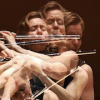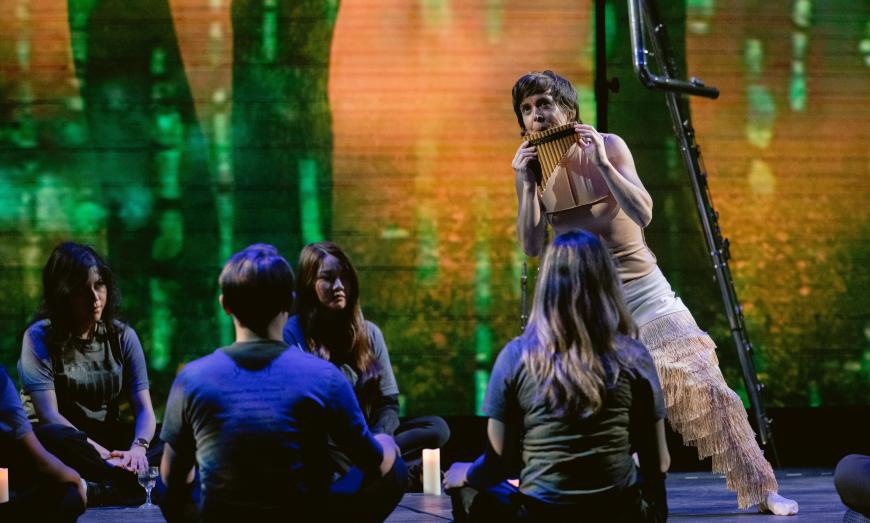
Just over five years ago, flutist Claire Chase gave an astounding recital in Berkeley under the auspices of Cal Performances. Among the pieces she played was a tantalizing half-hour fragment of Pan, a work in progress by composer Marcos Balter.
Since then, Chase has become a San Francisco Symphony collaborative partner, one of a group named by Music Director Esa-Pekka Salonen to help reimagine the orchestra for the 21st century. On Friday, Feb. 24, she gave the first local performance of Pan and also of its predecessor piece, Alone, for flute and two wine glasses.
Back in 2017, Chase announced that Pan was expected to be a 90-minute work. What she played on Friday lasted about 60 minutes and was fully formed. Maybe Pan was longer at one time — Balter evidently revised the piece within the last couple of years — or maybe it never grew to 90 minutes.
Regardless, Balter has composed two magnificent works, and Chase gave dazzling performances of both. Alone is just a few minutes long, haunted and circling around a few pitches, accompanied by video of a bird murmuration. The glasses were tuned to specific pitches, set by the amount of water in them, and two assistants ran their fingers around the rims to produce eerily pure tones with which the flute part harmonized.
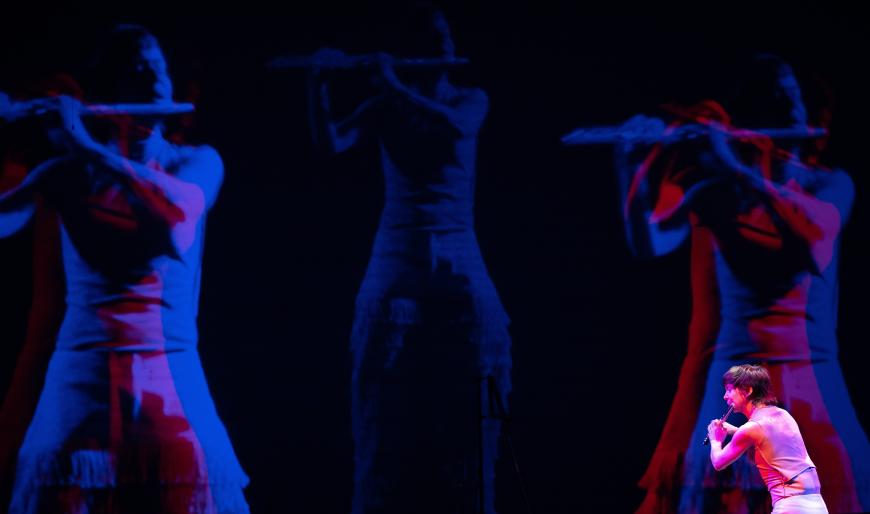
Chase introduced Pan briefly, telling the audience that Pan is the god of shepherds and flocks, a charmer and a trickster, half man and half goat. He’s godlike and human; he fails at everything. He misuses his power and loses the trust of the humans in his community. The flutist took note of her outfit for the evening: white pants with rows of fringes running down each leg and a sleeveless shirt of a shade close to that of her skin, imitating Pan’s appearance as closely as she could.
Pan is more than an extended flute solo, though. It’s a theater piece that makes great musical, physical, and dramatic demands on the flutist, every one of which Chase met handily.
For the performance, Chase was equipped with a body microphone, which is used not only to feed sound to the amplification system but to enable real-time processing. Pan also calls for community participation. In 2017, Chase asked for volunteers from the audience and taught them their part during a break. For this performance, 50 individuals from Casa Circulo Cultural, Openhouse, Amateur Music Network, the San Francisco Conservatory of Music, and San Francisco State University took part. They played percussion instruments, carried candles, and, crucially, represented Pan’s community.
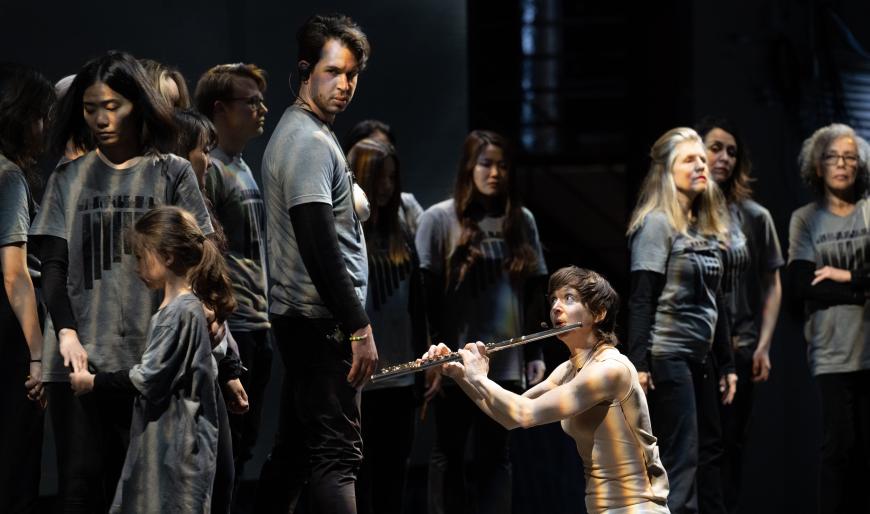
Pan is in nine short movements and opens at the end of the story with the “Death of Pan” and a “Lament for Pan’s Death.” The god dies in great pain because he has challenged Apollo to a musical duel. In this movement, the performer must sing, shriek, blend human sounds with those of the flute, and fall on the floor. During the “Lament,” the community members form a procession and walk from the back of the hall onto the stage.
In “Pan’s Flute,” Chase rises up from the floor, now playing panpipes, then switches to a piccolo, the giant screens of the SoundBox space displaying a green forest. Trills and bird calls follow; with her quick and restless movements, her glances here and there, it’s easy to imagine Chase as a creature of the forest. She takes a flute in hand and parades it about in wonder. One of the community members races offstage and out a door, a flute in her own hands.
The forest turns a bloody red. Lights flicker. Offstage, some community members play chimes as others form a procession and leave the stage. The movement “Music of the Spheres” follows, and Chase takes up her giant contrabass flute, the projections displaying a night sky, clouds, the aurora borealis, stars. Pan wheels about, the contrabass flute pivoting on its support and calling out like a whale vocalizing in the vastness of the ocean.
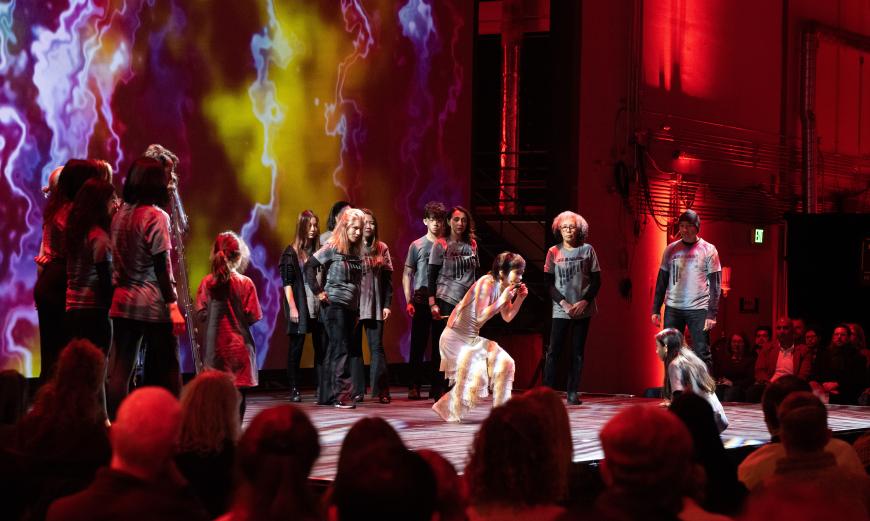
In “Echo,” the community members are scattered around the edges of the three stages, each with colored lights attached to their hands. It’s like having a sparkle of fireflies loose in the hall. Pan’s flute serenades the nymph Echo; the flute sound is processed to produce multiples flutes playing different pitches in parallel motion. It might be that the visual effects are partially controlled by the flute sounds.
In “Serenade to Selene,” Pan speaks to Selene, the moon goddess, but his speech is broken, spattered, incomprehensible nonsense syllables that still dance musically. He struts — he virtually beats his breast — as if demanding that Selene look at him. It’s a terrifying moment. Pan goes on to destroy the water nymph Syrinx in the movement “Dance of the Nymphs.” He and the community clap on their thighs ritualistically. There’s singing and chanting.
Things start to come apart. In “Fray,” Pan’s followers begin to turn against him. Chase makes violent movements. She huffs into her flute, contrabass flute, and piccolo. She paces back and forth onstage. She picks up the panpipes and shows them to her followers. A “Soliloquy” follows; Pan tries to make amends, too late, begging for forgiveness. Chase plays repetitive phrases on the flute for the community, but the group turns from her and walks offstage, abandoning Pan.
These words are not adequate to convey the beauty and mystery of Pan as a musical and theatrical work. All credit to Chase for her embodiment of Pan and flawless playing, to Balter for the glorious music, to Adam Larsen for the video projections and Luke Walker for the lighting design, to Levy Lorenzo for the original electronics and sound design, and to Ben Richter, artistic assistant and community choir director.



